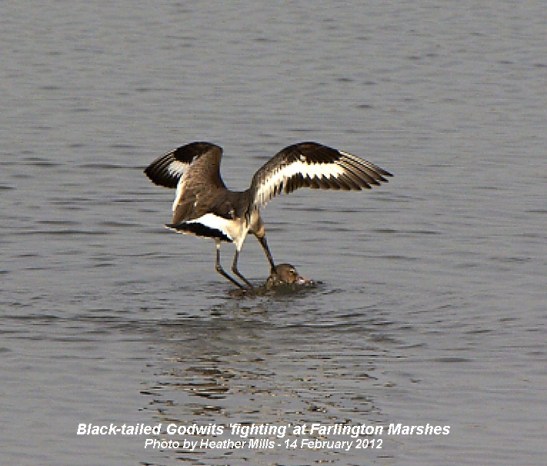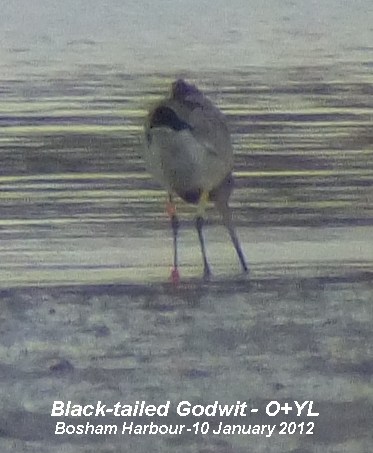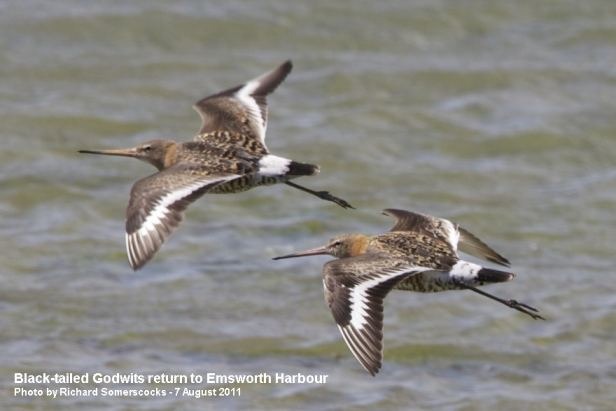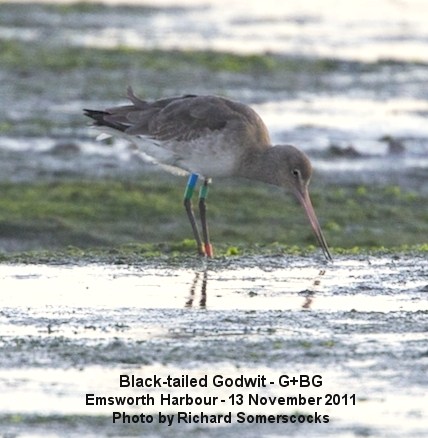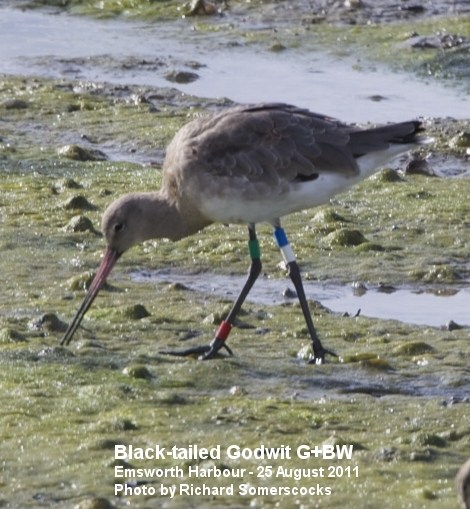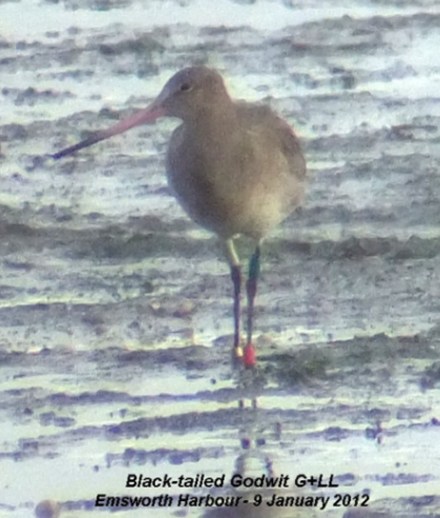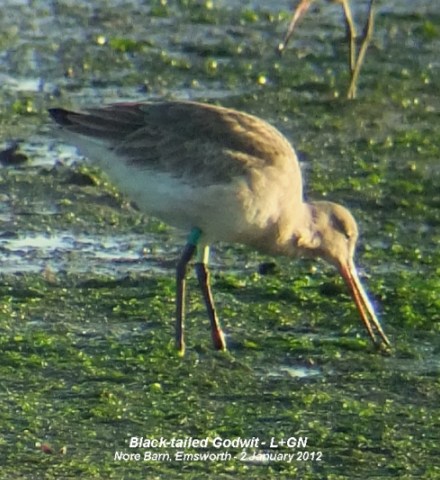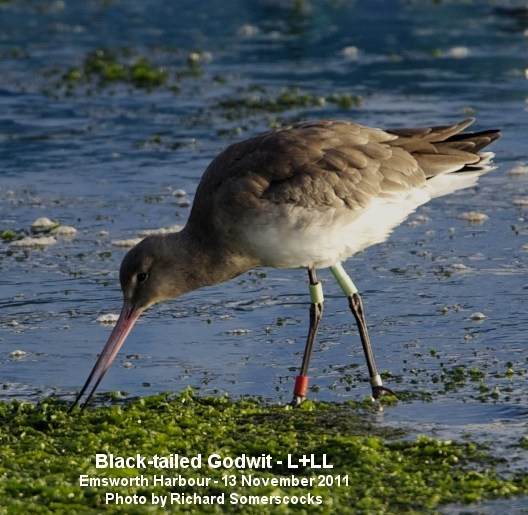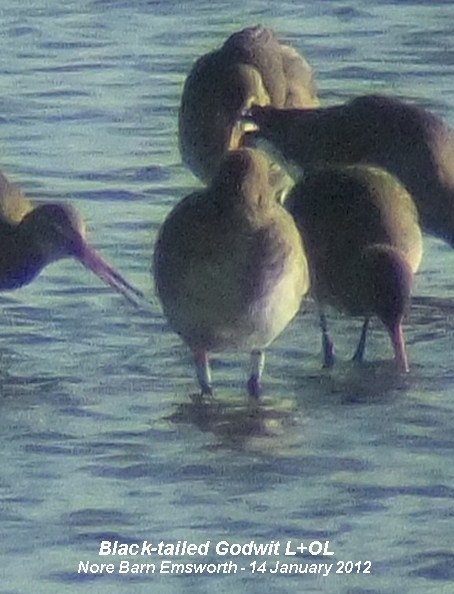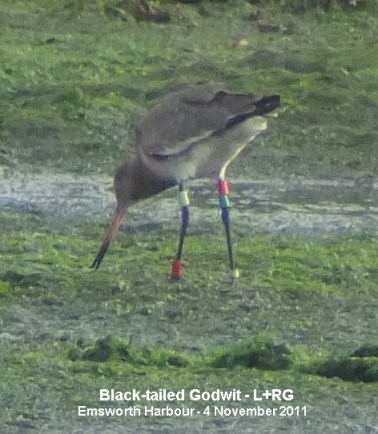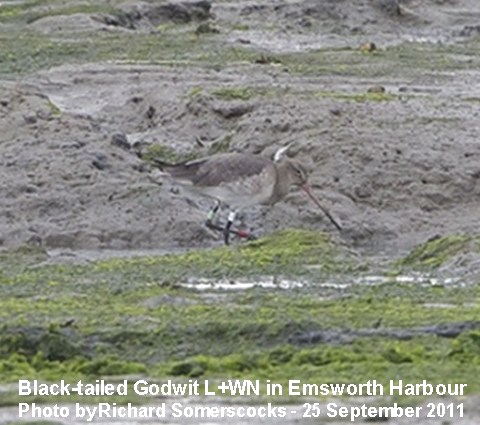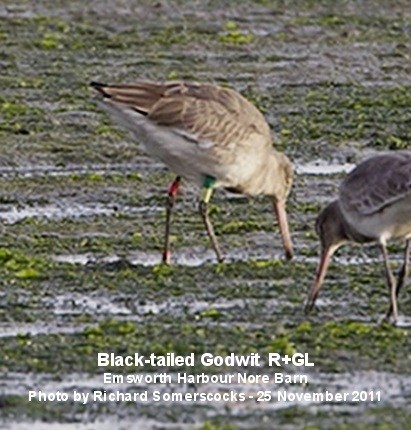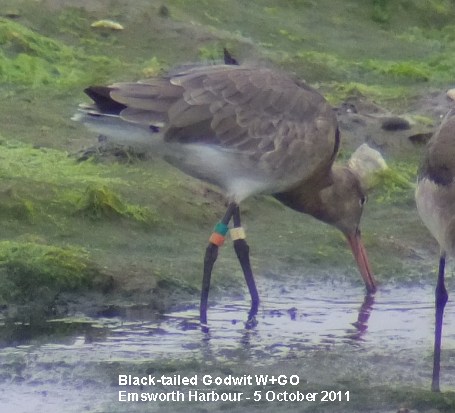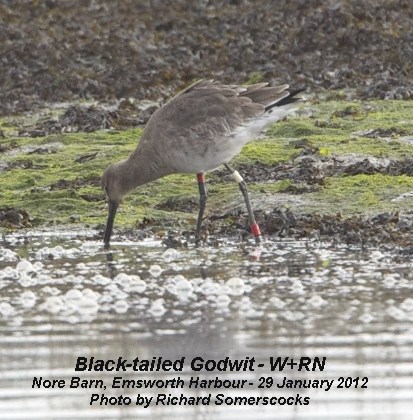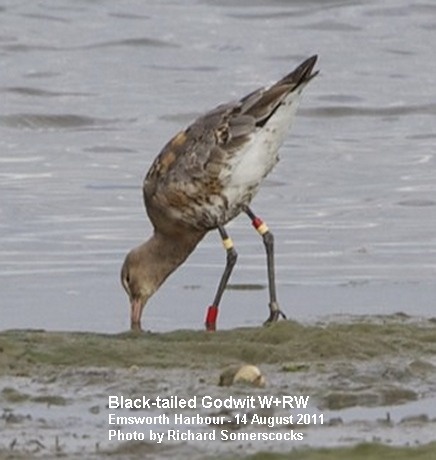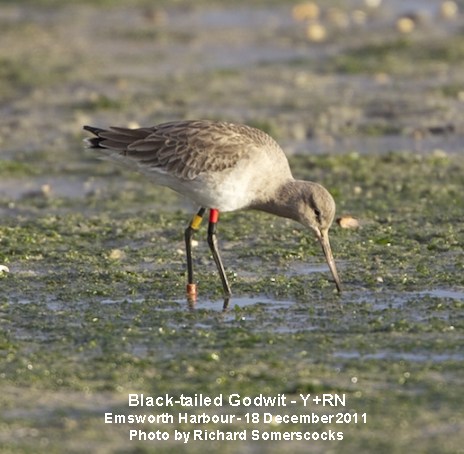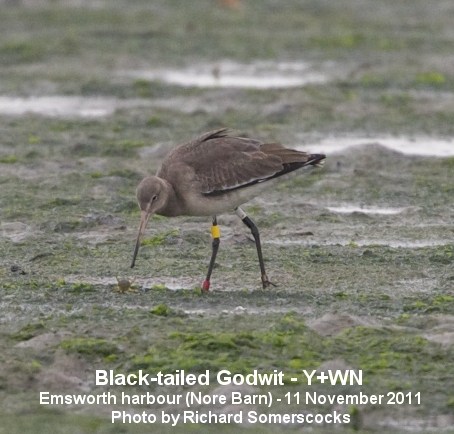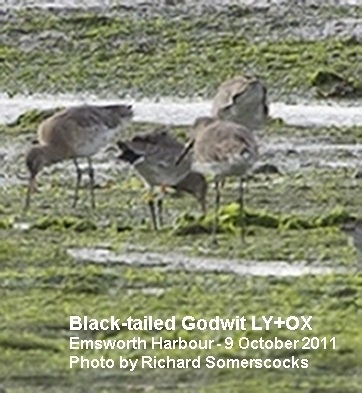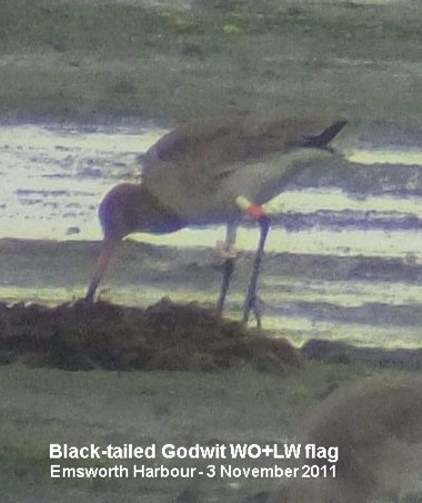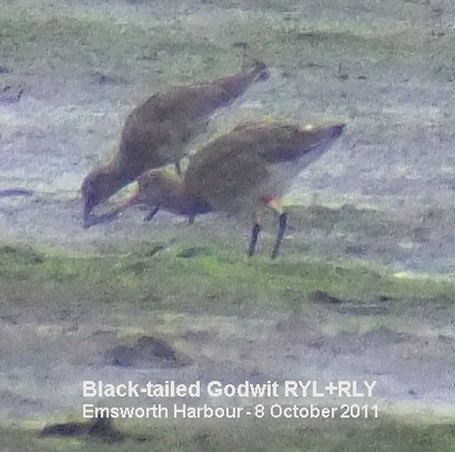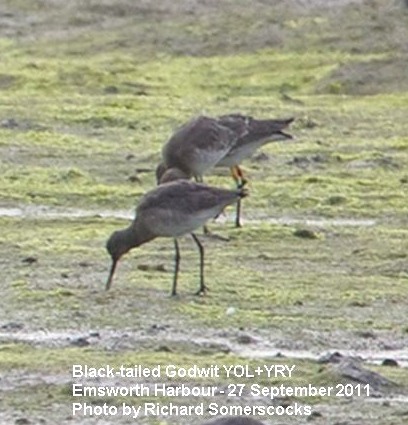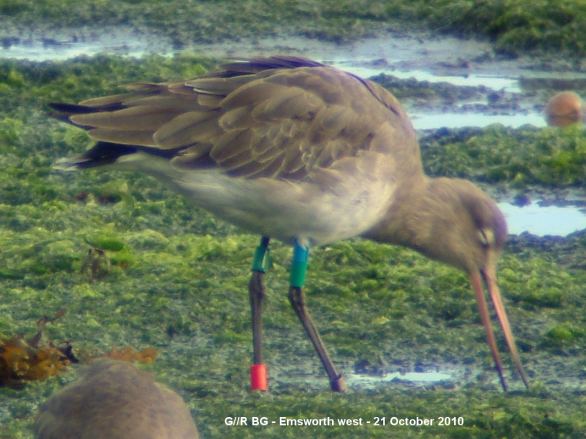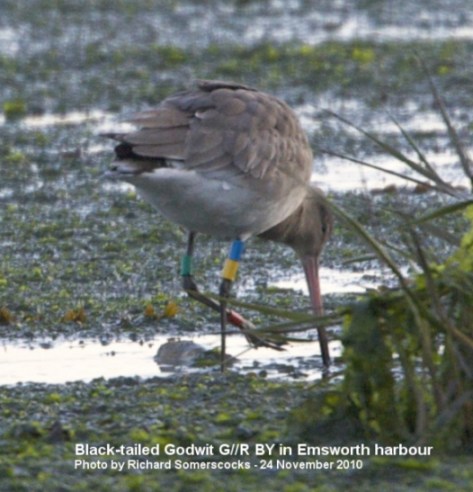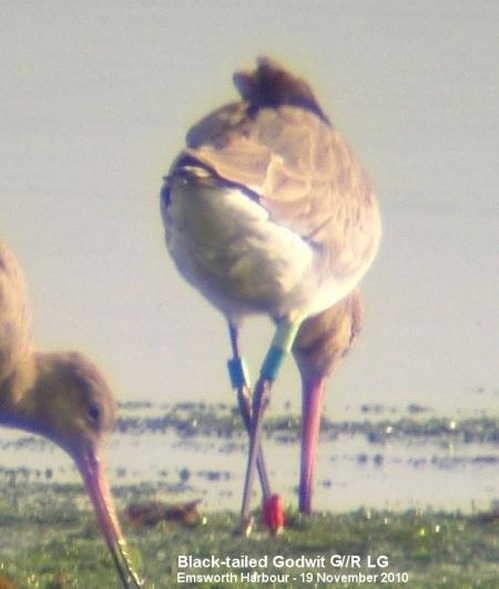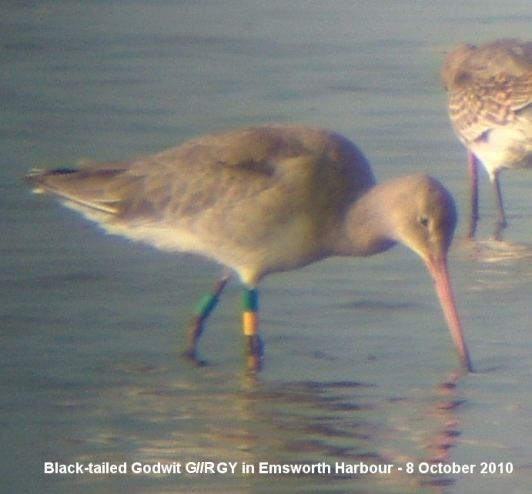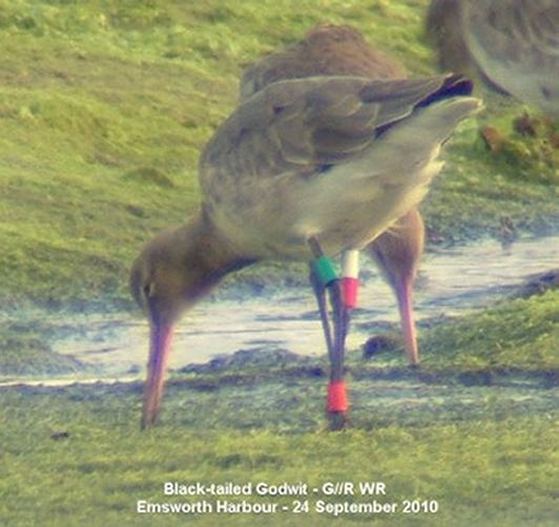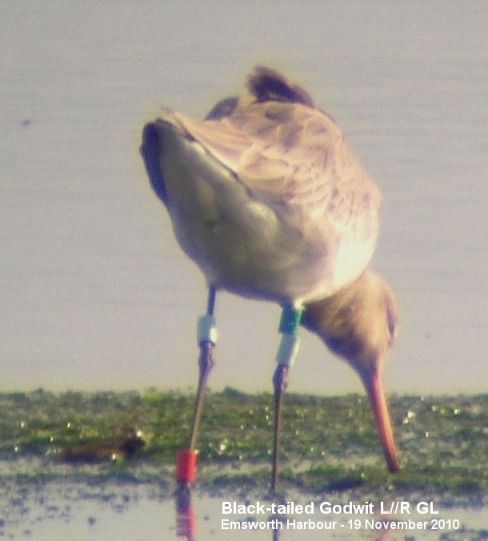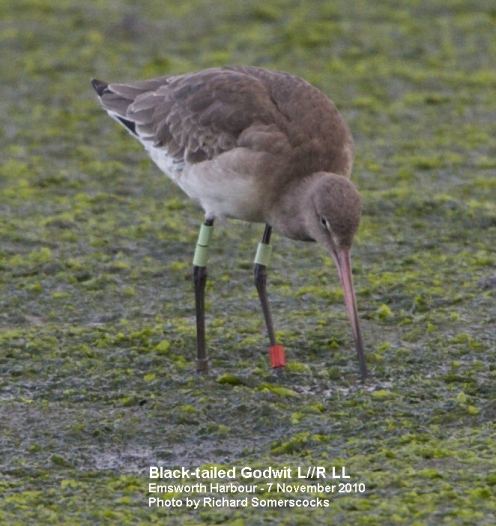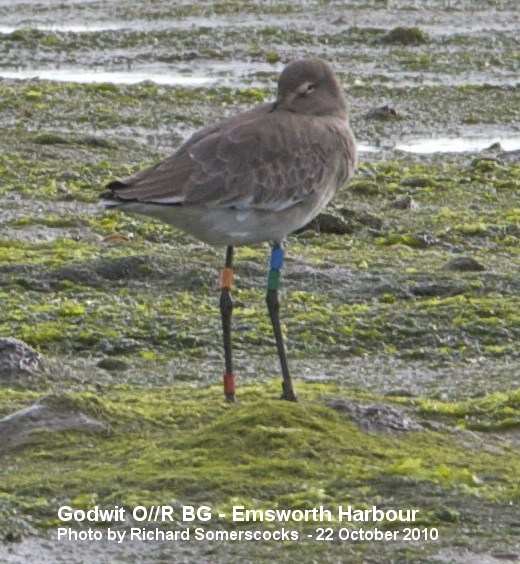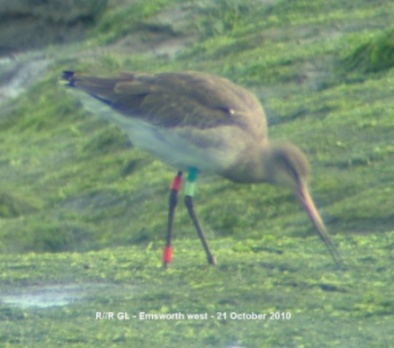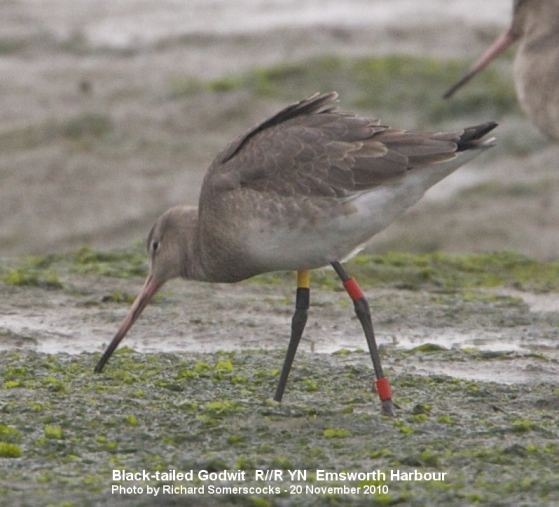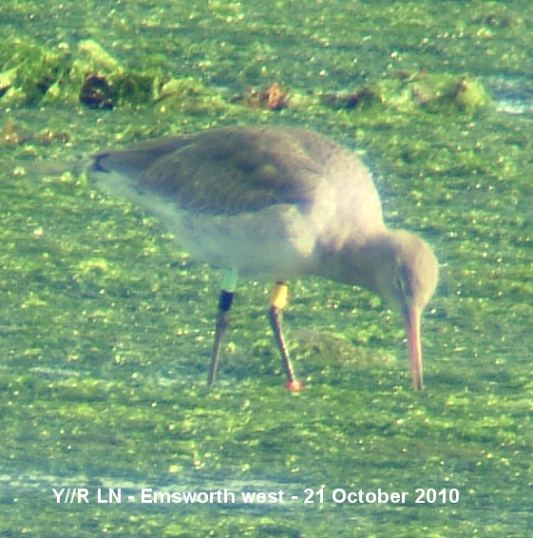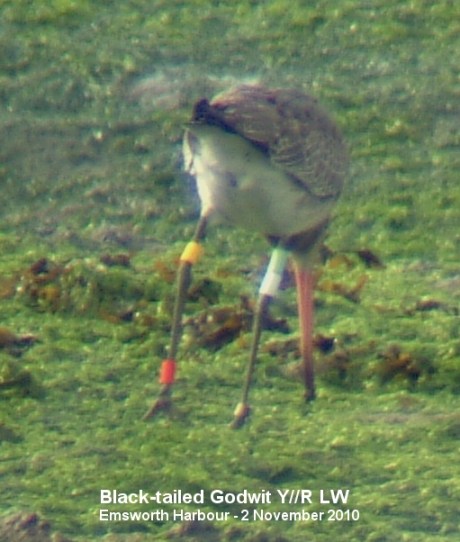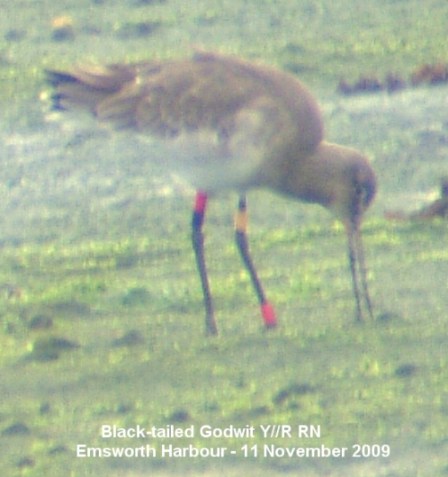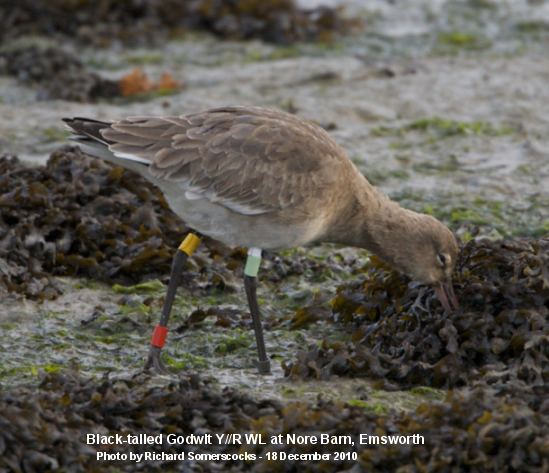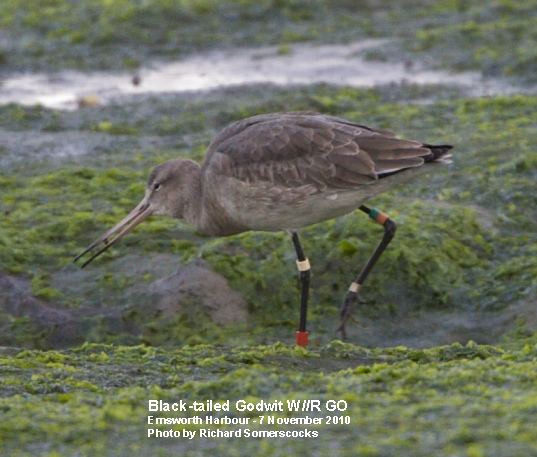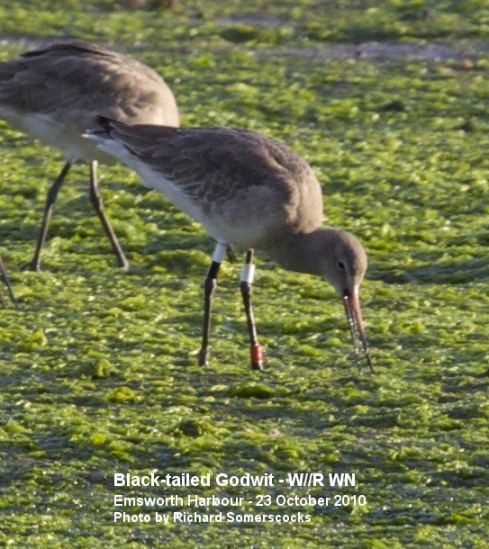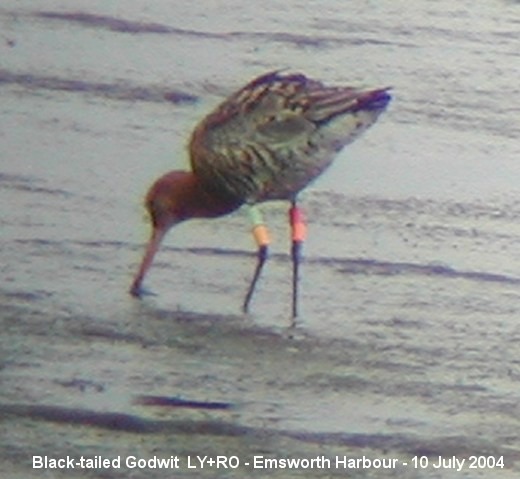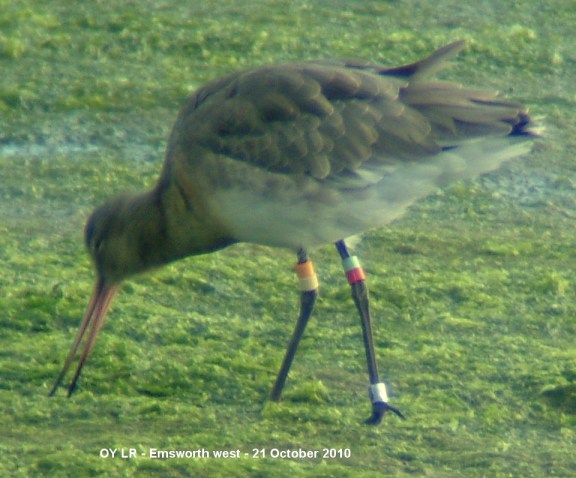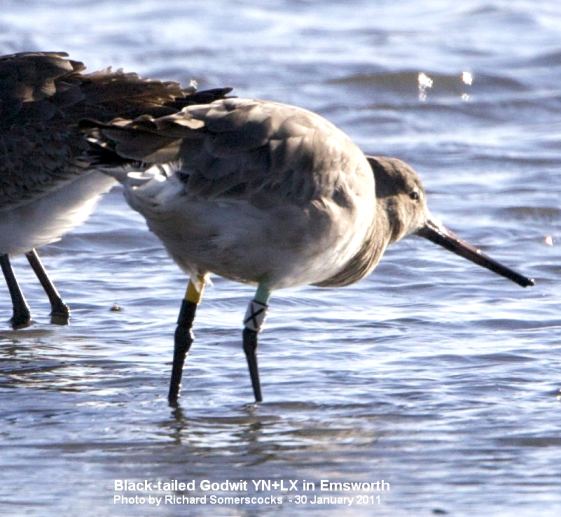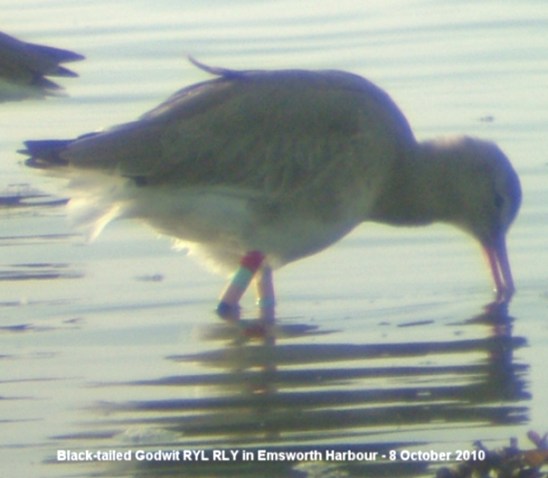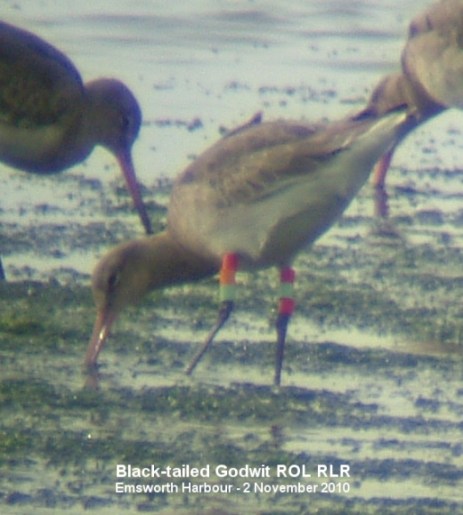RETURN TO . . . Emsworth Wildlife - Homepage
BLACK-TAILED GODWIT - 2011-12 SEASON
Colour-ringing information . . . Godwits season 2012-13 . . . Godwits season 2011-12 . . . Spurting behaviour
BLACK-TAILED GODWIT DIARY 2011-12
in reverse chronological orderGodwits fighting? - 14 February 2012
Heather Mills got this extraordinary photo of what appears to be two Black-tailed Godwits fighting. Heather says "Really vicious behaviour, but fortunately the underwater bird got away eventually". I have sent a copy of the photo to Pete Potts to see if he knows what is going on.
LOOKING FOR MISSING GODWITS - Tuesday 10 January 2012Godwit numbers have dropped quite dramatically in Emsworth Harbour from a regular 100+ for the last 3 months down to a mere handful. This also happened in the winter of 2006-07. The theory then was that the birds had exhausted the food supply in the harbour mudflats and had migrated to the lush fields and valleys. The fact that the present decline in Emsworth coincided with a big rise in Godwit numbers at Pulborough Brooks suggested this might be happening again.
I decided to check on the Pagham Harbour north fields this morning and was disappointed to find only 54 there, including one colour-ringed - O+GL - not an Emsworth regular. The fields looked quite dry and uninviting to Godwits. There no Godwits at Sidlesham either, and none on the recent sightings board. So, clearly the missing Emsworth Godwits had not gone to Pagham.
I had a quick at Bosham where there was about 200 Godwits, so clearly they have not deserted that harbour.
I am not sure if Pete Hughes has got any information about the colour-rings of the Pulborough Brooks Godwits, but I hope to go up there tomorrow to have a look. I assume they are on the north brooks as usual.
Pagham Harbour North Wall - 10:30 - 11:30I parked at the end of the lane by the Parish Church and walked to the North Wall. It was about 1 hour before high water, but the tide was not a high one at 4.6m so there was still some mudflats and saltmarshes showing in the main harbour. Several hundred Lapwing were gathered on the edges of the saltmarshes near the North Wall which was a very impressive sight. A large flock of several hundred Golden Plover were circling over the harbour - also impressive. Flocks of Brent Geese continually flew overhead from the harbour onto the north fields. This must be one of the best sites to see this spectacular display of flying geese. There is no shortage of birds in Pagham Harbour!
I walked to the end of the North Wall, but there were no Black-tailed Godwits. The only waders I saw were a group of 48 Curlew on the field on Halsey's Farm. I thought the fields looked remarkably dry, certainly not flooded, and I could see molehills dotted around. However, on the way back along the wall, I came across a group of 54 Godwits on the lake at the eastern end of the North Wall which were not there when I passed first time. There was just one colour-ringed bird among them: O+GL.
O+GL - has been seen in Emsworth Harbour, but only once on 27-Oct-06. It is certainly not one of our missing birds. I have also seen it at Fishbourne and Bosham. The most recent record I have is by Anne de Potier at Bosham on 13-Sep-11.
Sidlesham - 12:00
I drove over to the Sidlesham Reserve Centre, but there was no sign of any Black-tailed Godwits on the fields here. There were no Godwits on the sightings board in the reserve centre either. Clearly, the birds which have disappeared from Emsworth have not come to Pagham Harbour. I shall need to try Pulborough Brooks tomorrow?
Bosham Harbour12:30 - On the way home from Pagham I had a look at the upper reaches of Bosham Channel where there is often a high water Black-tailed Godwit roost. I found about 200 Godwits clustered along the upper shore of Colner Creek, so resolved to return later when the tide had fallen to look at them more closely.
15:00 - 15:30 - About 3 hours after high water. Parking on the shore to the east of the village, I walked across the green to have a look at the main channel. I could see a line of about 100 Godwits feeding on the far side of the channel.
At that distance and in poor light it was not easy to read colour-rings, but I think I got one which was L+LL. This one has been a regular in Emsworth Harbour this winter with 24 sightings, the last of which was on 05-Dec-11. I wonder if it has been over here at Bosham since then?
When I got back to the car, a lot of Godwits had arrived to feed on the emerging mudflats east of the town. They were fairly close to the shore and easy to view. I counted a maximum of 102 with just one colour-ringed: O+YL - This bird has been a Bosham and Fishbourne regular since at least 2006.
Nutbourne bay16:00 - The light was going rapidly, but there were no Black-tailed Godwits at all.
BLACK-TAILED GODWITS ON THE MOVE? - 6 January 2012There were just 10 Godwits on the mudflats in the Nore Barn Woods channel by the time I left at about 12:45 and no sign of any others anywhere else. This is the second day running they have not turned up and may mark the departure of the large flocks from Emsworth, which sometimes happens at this stage in the winter period. The food supply in the mudflats gets low and they migrate inland to feed on lush worms and other creatures in the flooded valleys and fields. So, Godwit numbers should rise in Pulborough Brooks and Pagham North Fields.
As I expected, 230 Black-tailed Godwits were reported at Pulborough Brooks today. I wager they included some of the Emsworth birds.
GODWIT FEEDING HABITATS - 30 October 2011Pete Potts provided some very interesting information in reply to my query as to why the Black-tailed Godwits have moved away from Fishbourne to Bosham and Nutbourne this year.
"The reason for shifts in godwit concentrations will be food supply. They predominantly feed on bivalve molluscs e.g. Scrobicularia plana. Once they have depleted them in one area, at least, to a numbers of a certain shell size that makes it not efficient to continue to feed there, they move to other places with richer pickings. Some of the bivalves they favour take several years to get to a worthwhile size for the godwits to eat; that is why the godwits vacate an area for a few years till the crop of molluscs is back to harvestable size once again. This is a bit over simplified but it is along the right lines.
Of course, godwits also eat marine worms but I think the molluscs are a better source of food energetically than worms on the inter-tidal. In the winter, during periods of wet weather, as we know, they rapidly move to favoured wet grassland sites to eat earth worms and tipulid (crane fly) larvae forced to close to the surface by flooding/water logging, e.g. at North Walls Pagham Harbour, Meon valley at Titchfield Haven, Avon Valley, Pulborough Brooks, etc.
So, the message is, all these creeks that godwits use on a cycle, sometimes with gaps of a few years, are vital to the species long-term survival. The large number of potential feeding sites (restaurants) offered in The Solent's harbours, estuaries and surrounding wet grassland, make this area such an important place for godwits to winter and stage on migration.
The survival analysis done comparing wintering godwits in The Solent and some east coast estuaries back in Year c.2000 showed that godwits wintering here at that time had a much higher annual survival rate than godwits wintering on Suffolk/Essex coast - Jenny Gill wrote all this up in her Buffer Effect paper in Nature. Whether this still holds true with milder winters and shifts in godwit numbers is not known, but it may well be the case. We can look at survival rates again and now that we have good samples marked on Suffolk and in N Kent and we have enough winters worth of data (i.e. resightings) we can re-do the survival analysis to see what has changed. However, the number of available habitats and proximity of wet grassland to mudflats has not changed.
PS if anyone is interested in coming out cannon-netting in The Solent I am always recruiting new team members and need good sized teams each time. You are welcome! Pass the word."
My follow-up questions
I asked Pete a few additional questions:
1. How do the Godwits manage to open the shells under the mud?
A: They don't open the shells. They eat the whole shell and crush them in their gizzards.2. Presumably the molluscs are eaten by other waders too?
A: Yes, probably but different waders eat different species and different age classes of bivalves and there is still much to learn.3. There is also a pattern of Godwit feeding in Emsworth Harbour. What I have noticed over the years, is that in July-Sept the Godwits concentrate in the eastern harbour and then move across to the western harbour from Oct onwards. Again, due to food supply I assume?
A: Emsworth Harbour local changes are very interesting; probably just depleting one food supply, then moving on to another rich picking. Is the roost site the same when feeding at each site?
ONE-LEGGED GODWITS? - 10 August 2011Ralph Hollins was fascinated by Richard Somerscocks's photo of a pair of Black-tailed Godwits in flight each apparently with only one leg each (see photo on August 8). Ralph asks, Were these genuinely one-legged? Or do Blackwits regularly retract one leg at a time?
In my experience Black-tailed Godwits do regularly stand on one leg with the other tucked up, usually when resting. They sometimes also hop around like this. As for flying, I have looked at some other photos I have of Blackwits in flight and many of the birds have only one leg showing.
Richard agrees that Godwits often stand on one leg when resting. He says, "They seem to do this more on an incoming tide - I suppose they have been feeding on the mudflats for longer and are not as hungry. When the tide is receding they are usually feeding more actively and tend to be on 2 legs. On an incoming tide they are often forced to get airborne for short distances in order to get onto higher bits of ground, which is what was happening when I took the photo. I think that if they have been standing with one leg tucked up then they will fly a short distance like that and land on one leg. However you frequently see them with both legs outstretched when flying."
Richard provides the following photo, taken at the same time as the earlier image, showing two birds with both legs showing and two with only one. The latter two birds may, as Richard suggests, have their other leg tucked in, or possibly the two legs were close together so that it looked as if there was only one leg.
Ralph's final comment:
"One of the thoughts provoked by Richard's picture was that it is not uncommon for waders to lose feet or even legs as a result of two causes - either by treading in the 'open mouth' of a large shellfish such as a clam (especially when forced by short daylight hours and winter hunger to feed in darkness when the tide is out) or by being alarmed by some threat such as a fox after one or both feet have become frozen to the mud while the bird is sleeping in very hard weather. I have heard of both disasters occurring and have seen a one legged Curlew that was feeding off Langstone in two successive winters and I have been told how someone from the Royal Oak at Langstone once rowed out to see what was wrong with a gull struggling but unable to take off from the water - they picked up the gull, found it had a large shellfish clamped to its foot and took it back to the pub where they removed the shellfish with a special hammer used for cracking the shells of crabs after which the gull was able to fly off apparently unharmed - unlike a Herring Gull which I personally saw drown in the IBM Lake at Portsmouth through having got a supermarket carrier bag hooked on its leg while feeding on the rubbish tip (now closed) across the M27 - the gull landed on the water, the bag filled with water and pulled the gull down to the bottom of the lake after its struggles to take off exhausted it."
COLOUR-RINGED GODWIT RECORDS
in Emsworth Harbour - Season 2011-12Observers - Brian Fellows, Richard Somerscocks, Caroline French, Heather Mills
Number of sightings of each colour-ringed Godwit - to 29 January 2012
Last winter's figures are included for comparison
2011-12
N
2010-11
N
G+BG
18
G+BG
11
G+BW
39
G+BY
2
G+GY
5
G+LG
1
G+LL
2
G+GY
4
G+WR
45
G+WR
22
L+GN
1
G+YB
1
L+LL
24
L+GL
1
L+OG
1
L+LL
4
L+OL
1
L+LN
1
L+ON
1
L+WR
2
L+RG
1
O+BG
6
L+WN
2
O+RO
11
O+GB
12
R+GL
6
O+GL
2
R+YN
1
O+OL
1
W+GO
14
R+GL
14
W+WN
2
R+GN
4
Y+GW
2
W+GO
19
Y+LN
12
W+LW
1
Y+LW
5
W+RN
1
Y+RN
1
W+RW
0
Y+YN
1
W+WN
44
Y+WL
1
Y+RN
5
LY+RO
2
Y+WN
1
OY+LR
2
LY+OX
1
YN+LX
1
OY+LR
12
WO+LW-flag
12
WO+LW flag
10
RYL+RLY
8
YOL+YRY
2
ROL+RLR
17
ROL+RLR
35
RYL+RLY
14
PHOTOS OF COLOUR-RINGED SIGHTINGS IN 2011-12
G+BGRegular in Emsworth from Sep to Nov 2010. First sighting this season on Sep 16 2011
G+BWA new one for Emsworth Harbour in 2011-12 - First sighting 12-Aug-11
G+GYFour sightings Aug - Oct in 2010. First sighting this season 16 Sep
We have no photo for 2011 as yet. Here is one I took in Emsworth in October 2008.
G+LLG+LL was ringed on 13-Aug-08 at Farlington Marshes. First Emsworth record 9 January 2012. Never recorded before in Emsworth Harbour. I last saw it last on Pagham Harbour north fields in November 2008, but Richard Somerscocks found it on Shut Lake, Farlington Marshes on 11-Aug-11. Today, the left leg ring occasionally looked blue in some lights, but I am fairly sure it was green.
G+WRG+WR was ringed at Farlington Marshes on 10Sept08 as adult male. It has been a regular wintering bird in Emsworth Harbour since then. Last winter it was here from Sept to Jan. First sighting 2011-12 was on 8 Aug.
L+GNFirst record for Emsworth Harbour - 2 January 2012. I have only had two previous sightings of it: on 14-Nov-08 at Farlington Marshes and on 16-Mar-10 in 'Texaco Bay' North Hayling.
L+LLFirst seen in Emsworth in Nov 2009. Seen 4 times in Emsworth last winter between Nov and Jan. First sighting in Emsworth in 2011-12 was on 24 Sept.
L+OGWe had 7 sightings of this one in Emsworth Harbour in Dec-08 and Jan-09, but no others until 3 Dec 2011 when Richard got this shot of it. Richard also saw it at Chalkdock, Langstone on 26 November 2011.
L+OLFirst Emsworth sighting - 14 January 2012. Richard Somerscocks did see it at Farlington Marshes on 04-Sep-10.
L+ONFirst Emsworth sighting on 4 Nov 2011 - Richard did not get a good photo of L+ON so here is one he took on 11 August 2011 at Farlington while it was still in its summer plumage.
L+RG4 Nov 2011 - A first for Emsworth. My only previous sighting was on 16 Mar 2011 in the Texaco Bay', North Hayling. The lime ring looked yellowish in bright sunshine, but was certainly lime.
L+WNL+WN - 25 Sept 2011 - First sighting this season. My only other record was a sighting by Anne de Potier in Nutbourne Bay on 10-Dec-10
O+GBFirst sighting in Emsworth on 3 Dec 2011. We have no previous records of this combination before then.
O+GLRecorded 14 January 2012. Last recorded in Emsworth way back on 27-Oct 2006. Since then most records have come from Bosham. However, it was the only colour-ringed bird that I recorded on the Pagham Harbour north fields when I was there two days ago on 10-Jan-12. So this bird has moved from Pagham presumably with some of its feeding companions.
O+OLRinged as first summer male Thorney Island 26-Jun-05. Seen mainly in Fishbourne until this season. First sighting in 2011-12 was on July 21.
R+GLFirst sighting in Emsworth on 28 September 2011.
25 November 2011 - We have puzzled over this one throughout the winter. Is it GL or is it GY ? In some lights it looks one and in others the other. My inclination is to go for GL. If it was GY then the yellow ring would be much brighter. I have been through all 12 records for this year and they all show the same bird, though sometimes described as R+GL and other times as R+GY. These records will need to be changed to make them consistent. I have taken a couple of photos from past records where lime and yellow rings were used together to illustrate this point.
Here is Richard's photo from 25 November 2011
R+GNA new one for Emsworth Harbour in 2011-12 first sighting on 14-Aug-11,
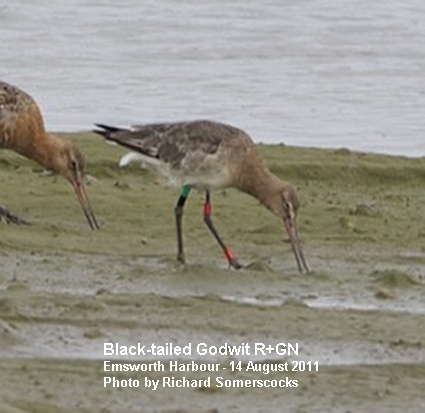
W+GOW+GO - Ringed at Farlington on 20 Oct 1995 as an adult male. That makes him at least 17 years old. There has been a huge number of local sightings and some in Iceland on breeding grounds. First seen in Emsworth Harbour on 20 Sep 1996 it has been regular each year, clocking up over 90 sightings. It was regular Nov - Feb in 2010-11 season. First sighting this season 23 Sep. Note: The early ringed birds, like this godwit, all have short rings; the later ringed ones have tall rings.
W+LW6 November 2011 - First ever sighting in Emsworth (Nore Barn) by Richard Somerscocks
W+RN29 January 2012 - a new sighting for Emsworth this season.
W+RWA new one for Emsworth Harbour in 2011-12 first sighting on 14-Aug-11,
W+WNSeen in Emsworth last winter in October. More regular this season.
Y+RNY+RN was seen 3 times in Emsworth in Nov 2009 and again in Nov 2010. In 2011 Richard Somerscocks had one sighting of it at Farlington on 11-Aug-11 and in Emsworth on Dec 18.
Y+WNFirst recorded in Emsworth Harbour on 11 November 2011 by Brian Fellows and Richard Somerscocks. In fact, I have no previous records for this combination at all.
LY+OXThe X denotes a white ring marked with an 'X'.
First sighting in Emsworth on 9 October 2011. This bird has been seen in the Chichester Harbour area for some years, but not before in Emsworth Harbour to my knowledge. I last saw it in 'Texaco Bay' North Hayling on 16-Mar-11. It was ringed on 27.04.02 at Grafarvogur, Reykjavík, SW Iceland.
Richard's photo is poor and we shall try to get a better one, but Richard was confident in accuracy of the reading.
OY+LROY+LR was ringed as a chick in Iceland in July 1999 and has been a regular Solent winterer ever since. It has often been seen in Emsworth Harbour over the years and last year it was here in Aug and Dec. First sighting of 2011-12 was on 25 Sept.
WO+LW flagFirst sighting in 2011-12 was on 3 November 2011. Godwit WO LW flag was a chick ringed in north Iceland by Ruth Croger and Pete on 13th July 2010 This was only the 4th godwit chick that has wintered in The Solent from all over Iceland!
4 Nov 2011 - Dudley Hird reported WO+LWflag was last seen in Kent on October 14th which was their 9th sighting this passage and was first seen on August 2nd . To his knowledge it has only been sighted in Kent and Solent. Dudley added that the white flag was very discoloured at first but got progressively better.
ROL+RLRFirst sighting in 2011-12 was on Oct 8 2011.
ROL+RLR has been an Emsworth regular from Oct to Jan over the past two winters. It was ringed on 27 Oct 08 at Kingsnorth Power Station, Medway Est. Kent as an adult male.
RYL+RLYFirst sighting in 2011-12 was on 8 October 2011
It was ringed in Kent in autumn 2005 and has been a regular in Emsworth Harbour ever since, usually arriving in early October and leaving in January. In late September Dudley Hird said RYL-RLY had been seen regularly in Kent this passage and predicted it would be with us soon. Spot on prediction, Dudley!
My photo of this familiar godwit only shows the left leg, but I got a reasonable view of both legs.
YOL+YRYYOL YRY was ringed at Seaton LNR, Axe Estuary, East Devon on 5 March 2011 by Mike Tyler et al as a first summer female Note: YRY is the marker for godwits ringed by Mike Tyler on the Axe Estuary. Other rings from G, O, L, R or Y. All rings are on the tibias. It was seen on Somerset Levels in May 2011. Then went to Iceland. The first sighting of the new season was in Emsworth on 26 Sep 2011. It was our first ever sighting in Emsworth of a Devon ringed godwit.
Colour ring records for the winter of 2010-11 . . . Total = 28 Correct to 9 February 2011 - See below for all the photos
Colour ring combinations
PHOTO
Number of sightings in Emsworth 2010-11
G+BG
Yes
11
G+BY
Yes
2
G+LG
Yes
1
G+GY
Yes
4
G+WR
Yes
22
G+YB
Yes
1
L+GL
Yes
1
L+LL
Yes
4
L+LN
Yes
1
L+WR
Yes
2
O+BG
Yes
6
O+RO
Yes
11
R+GL
Yes
13
R+YN
Yes
1
Y+GW
Yes
2
Y+LN
Yes
12
Y+LW
Yes
6
Y+RN
Yes
1
Y+YN
Yes
1
Y+WL
Yes
1
W+GO
Yes
12
W+WN
Yes
2
LY+RO
Yes
2
OY+LR
Yes
2
YN+LX
Yes
1
WO+LW (flag)
Yes
11
RYL+RLY
Yes
8
ROL+RLR
Yes
16
PHOTOS OF COLOUR-RINGED GODWITS SEEN IN EMSWORTH HARBOUR IN WINTER 2010-11
G+BG
Regular in Emsworth this autumn:
G+BYNEW to Emsworth on 23 November 2010. There is a possible confusion with G+GY which I have also recorded in Emsworth this winter. But the colours are clear in the following image by Richard Somerscocks.
G+LGMy only previous sighting: 07-Apr-10 in Texaco Bay Hayling Island
G+GYRegular in Emsworth this autumn:
G+WRRegular in Emsworth in autum 2010
G+YBA newcomer. I have never seen this one before. Probably newly ringed?
L+GLPreviously seen this season in September in Kent by Dudley Hird. I saw it once last winter on 27-Oct-09 in Nutbourne. It was also seen in the previous winter in Itchenor.
L+LLNew to Emsworth in November 2010, but I had three sightings of it in November last year, but none since.
L+LN9 November 2010 was my first ever sighting of L+LN in Emsworth. My only sighting was at Hayling Oysterbeds (north bay) on 16-Mar-10.
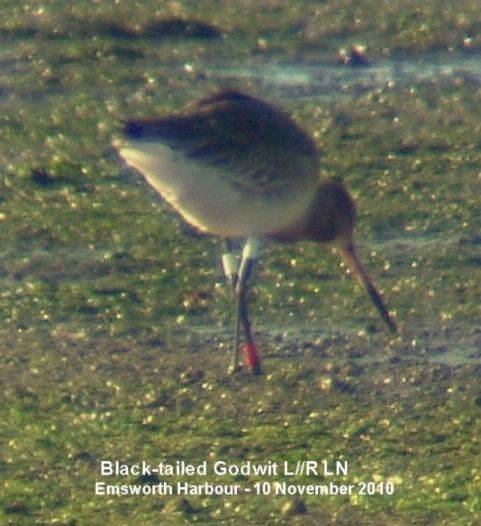
L+WR02-Nov-10 - a newcomer. I have never seen this one before.
O+BG22-Oct-10 - I am grateful to Richard Somerscocks for getting this good image of a Godwit that I had seen a couple of times, but had never been really sure of. I put it down as O+GG, though was unsure about right leg rings. Richard's image clearly showed the rings as O+BG. So I have corrected my entries. Clearly, Pete Potts used B (blue) rings in the recent ringing session on Farlington Marshes. We have already had three of them turn up in Emsworth. However, putting them next to a green ring was not the best choice for recording in the field.
This season's sightings: 14-Sep-10, 04-Oct-10, 22-Oct-10,
O+RORinged June 2005 on Thorney Island. A regular in Emsworth 2005-06 and 2006-07. Mainly seen in Fishbourne in the following winters.
This photo was taken in 2006
R+GLRegular in Emsworth in autumn 2010
R+YNNew to Emsworth - November 2010. Previously seen at Farlington Marshes on 12-Sep-10.
Y+GWThis bird was seen in Emsworth Harbour by Richard Somerscocks on 19 Sept 2010. This was a new one for Emsworth.
Y+LNPreviously seen twice this autumn in Fishbourne Channel. Never seen before in Emsworth.
Y+LWFirst ever sighting of this Godwit in Emsworth in November 2010.
Y+RNSeen three times in Emsworth in November. 2009 and came back in November 2010
This photo was taken in 2009.
Y+YN19 Nov 2010 - First ever sighting.
Y+WLFirst sighting in Emsworth by Richard Somerscocks on 18 December 2010
W+GOThis is an old friend returning to Emsworth in November 2010 after a long absence. I first saw it in Emsworth on 20-Sep-96 since when I have recorded it 80 more times. It was a mega regular in the winters of 2005-06 and 2006-07 when I recorded it 60 times, but I have not seen it since 10-Dec-06. It is good to see it back.
W+GO was ringed at Farlington on 20 Oct 1995 as adult male, which makes it at least 16 years old, a good age for a Black-tailed Godwit, though not a record. The rings are thin, not tall like those used in recent years. The W ring has become discoloured over the years and now looks creamy in some lights and could be mistaken as yellow.
W+WNI have had no previous sightings of this c-r Godwit, so I assume it is a newly ringed bird. This photo was taken by Richard Somerscocks on 23 October. The second sighting this autumn in Emsworth.
LY+RO11.6.03 Ringed in Langhús, Fljót Iceland on territory as breeding male. It has been regularly seen in Emsworth each year, but not often. Anne de Potier describes it as a good traveller. It's been seen in Ireland, France and Portugal as well as the local harbours and Pagham. She last saw it in Portugal! Here is a photo taken in Emsworth July 2004 with the bird still in breeding plumage.
OY+LRThis is a bird ringed Iceland in July 1999. It often been in Emsworth over the years. I have 18 sightings. I have also seen it at Warblington and North Hayling.
YN+LXThis is a new colour-ringed Godwit to Emsworth. With two colour-rings on each leg I suspect it was ringed in Iceland, maybe as part of the last summer's catch.
WO+LW (flag)This is a distinctive Godwit as the lower W ring on the right leg has a flag attached. Richard Somerscocks saw it for the first time in Bosham on Nov 6 and then here in Emsworth on Nov 14. Since then it has been fairly regular in the Godwit flock at Nore Barn. This is a chick ringed this summer in Iceland by Pete Potts and his team - see details above.
5 December 2010 - 9th sighting in Emsworth. Photo by Richard Somerscocks.
RYL+RLYRinged in Kent in 2005. Its arrival dates in Emsworth have been remarkably consistent over the past 5 years: 2006 Oct 13. 2007 Oct 16. 2008 Oct 3. 2009 Oct 15. 2010 Oct 8. Dudley Hird sees it first, in Kent, in early July, where it spends the next few weeks before making the journey to Emsworth. In 2010 it was in Kent on July 2.
ROL+RLRAnother Kent-ringed bird. Seen for the first time in 2009-10 winter in Emsworth Harbour between 23-Oct-09 and 10-Jan-10. It returned in winter 2010-11 on Oct 24, three days after being seen in Kent by Dudley Hird. It was ringed on 27-Oct-08 at Kingsnorth Power Station, Medway Est. Kent as an adult male.
